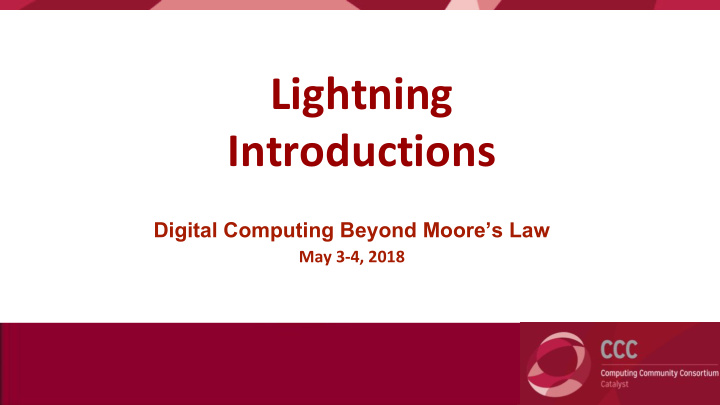



Lightning Introductions Digital Computing Beyond Moore’s Law May 3-4, 2018
Sarita Adve/University of Illinois at Urbana-Champaign Rethinking the hardware-software interface Heterogeneous memory systems Approximation
Srinivas Aluru/Georgia Tech ● Expertise at the intersection of high Picture performance computing and biology/medicine ● Application-specific and architecture-aware parallel algorithms research in bioinformatics/ computational biology
Saman Amarasinghe/MIT What do you hope to bring to the workshop? Picture
Daniel Armbrust/Silicon Catalyst Expertise in semiconductor processing, Picture design and materials Experience in consortia and collaborations Experience in hardware incubator Beyond Moore’s Law perspective
Krste Asanovic/UC Berkeley/RISC-V/SiFive Experiences in building open-source silicon Picture community. Development of productive environments for building and deploying specialized silicon with accessible NRE. Affiliation Logo
Rastislav Bodik/University of Washington Automatic synthesis of programs Applications in mapping SW to accelerators. Beyond synthesis of programs : generate specs, consistency models, new instructions, compilers, interfaces.
Aydin Buluc/Lawrence Berkeley National Lab Scalable parallel algorithms for scientific Picture data analysis problems: ● Machine learning ● Graphs as matrices (http://graphblas.org) ● Computational biology
Michael Carbin/MIT Experience developing programming models for new software/hardware domains. Perspective that advances in programming languages create new opportunities for programmability, performance, correctness, and reliability.
Jason Cong/UCLA Customizable Domain-Specific Computing -- Architecture, compilation, & runtime support FPGA-based acceleration in the cloud High-level synthesis (Vivado-HLS) Acceleration of computational genomics
Tom Conte/Georgia Tech Perspectives from the IEEE Rebooting Computing Initiative and The International Roadmap for Devices and Systems 2017 edition and bad jokes
Christopher De Sa/Cornell University A machine learning perspective. Picture Interest in ML accelerators as a major class of new beyond-Moore’s-law architectures.
Khari Douglas/CCC Personal Photo How can we continue to build on the outcomes of the workshop? Academia or Industry Logo
Ann Drobnis/CCC An understanding of how we can bring Picture this community together to ensure continued growth Affiliation Logo
Mattan Erez/UT Austin Expertise in memory systems, resilience, and the interactions of architecture with runtimes and programming models An eagerness to learn and interact
Mary Hall/University of Utah Expertise in: compiler and programming system technology for high-performance computing Interest in: new programming system technology requirements for novel high-performance architectures
Peter Harsha/Computing Research Association Hoping to learn what a research agenda in this area looks like and how we can best convey that to policymakers. (Unofficial logo)
Mark D. Hill/University of Wisconsin-Madison With apologies to “Field of Dreams” [1989]: Picture If we build them, will they come? we==hardware designers them==accelerators they==application developers UW-Madison & CCC Vice Chair & Google Hardware Sabbatical
Ji Lee/NITRD NCO What do you hope to bring to the workshop? Picture
Sasa Misailovic/University of Illinois Interest in improving performance, energy efficiency, and resilience in the face of software errors and approximation opportunities. Experience in probabilistic program analysis and compiler optimization under uncertainty.
Kunle Olukotun/Stanford University/SambaNova Domain Specific Languages High-level Compilers Domain Specific Accelerators Machine Learning
Jonathan Ragan-Kelley/UC Berkeley Graphics, Vision, Computational Imaging Domain-specific languages Halide (dense, differentiable ) Simit (sparse) Opt / ProxImaL (optimization) Domain-specific architectures
Chris Ré/Stanford University Experience with Machine Learning and Data Picture Applications (Software 2.0) New ML Algorithms with interesting systems aspects (Low-precision, compression, coordination-free)
Adrian Sampson/Cornell A perspective: programming languages and compilers can take responsibility for concepts that traditionally live in the hardware domain. An application: real-time, embedded vision.
Daniel Sanchez/MIT Experience in hardware-software codesign for data-intensive and hard-to-parallelize algorithms. Interest in graph analytics and other irregular applications.
Vivek Sarkar/Georgia Tech What do you hope to bring to the workshop? Picture A vertical approach to programming systems that spans programming models, compilers, and runtimes, for a wide variety of hardware platforms.
Gunasekaran Seetharam/ONR and NRL What do you hope to bring to the workshop? Low latency, real-time and forensic application based technical insights from DoD C4ISR perspective. Where to compute, what compute with, and what to provision & where?
John Shalf/Lawrence Berkeley National Lab Discussion of how we can link discoveries in fundamentally new materials and devices Picture up to computer architecture and computer science. Cross-link to DOE’s Exascale (former deputy director for Hardware) and to emerging Cross-agency (DOE/DOD) efforts in Beyond Moore technologies. Affiliation Logo
Armando Solar-Lezama/MIT Experience in programming systems Program synthesis Applications of ML to programming problems
Edgar Solomonik/University of Illinois Perspectives on key challenges in parallelism Picture and communication cost for numerical algorithms and applications, in particular, tensor methods, software, and computational quantum chemistry on parallel architectures.
Josep Torrellas/University of Illinois Basic hardware architecture Picture primitives to use in specialized platforms One example is in graph applications
Jeffrey Vetter/Oak Ridge National Laboratory Experiences and perspectives on integrating emerging technologies (GPUs, NVM, FPGAs, Quantum) into HPC architectures, and preparing the software ecosystem and application community. PMES16: http://j.mp/pmes2016 PMES17: http://j.mp/pmes2017 DOE Workshop on Extreme Heterogeneity: http://bit.ly/doe-eh2018
Kathy Yelick/UC Berkeley Understanding of scientific applications and Picture high performance computing, as well as code generation and performance optimization
Cliff Young/Google Brain Perspective from building TPUs for machine learning and Anton supercomputers for molecular dynamics. A focus on application requirements and non-requirements.
Recommend
More recommend